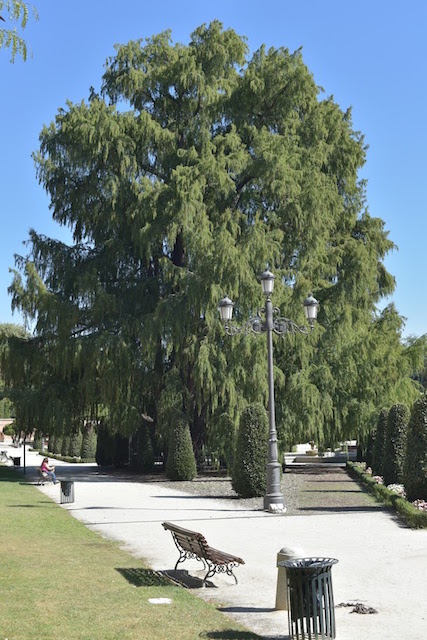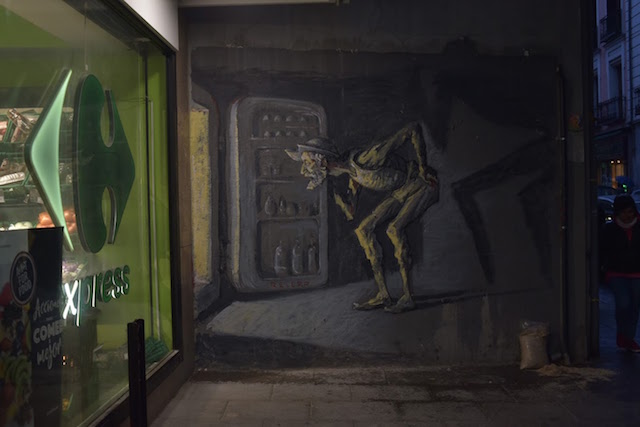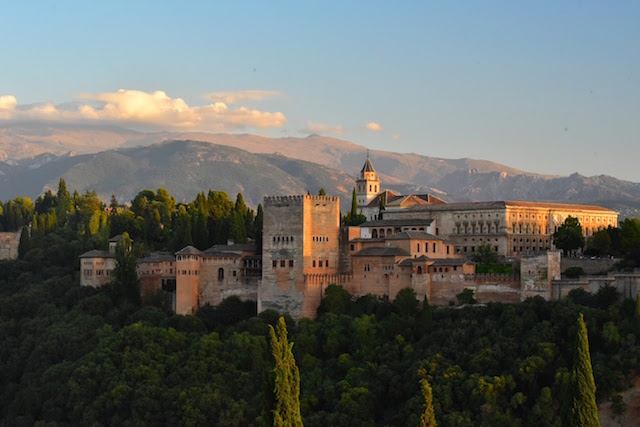
Text and photos by Pete Shaw
October 6, 2018
Dear Dad,
Spain makes a lot of olive oil. This I have known, but now it is something I understand to my core. Halfway through this four-point-five hour bus ride between Madrid and Granada, nearly every spot of land that is not residential is an olive grove. And in this clearly hardscrabble neck of the woods–it is a furnace here in the Summer, and I would gather Winter, on the hillsides of these craggy moderate-sized mountains, too is hostile–there are not many signs of human life beyond these well-spaced and clearly manicured olive trees.
It feels an interesting taste of what is to come. Granada is deep in Andalusia, and I read quite a bit about the many clear signs of the Moorish influence there. In fact, quite a few of the small towns we have recently passed have some bits of architecture reflecting this. It will only get more intense the further south we go. Islam forbids creating images of people and other animals, and from the photos I have seen, there is an unsurprising sense of geometric order–symmetry–to much of the architecture in Granada. I suppose this is most often noted by people who visit the Alhambra, the old Muslim, and later, Christian, palace and fort.
Ah, geometric order, indeed. One of the nice things about traveling is that when faced with the challenge of navigating a mass of people and cultures of which you are almost entirely ignorant, is that you end up constructing a trip that screws with your mind. In fact, I consider this a fundamental goal of any day.

This tree, in Madrid’s Retiro Park, was planted in about 1613.
Pacing and timing are everything.
About 24 hours ago, Jessica and I were in Madrid’s Prado Museum. We had one full day in Spain’s capital city, and being chock full of ambition, I figured we would also take in the Reina Sofia.
The Prado is a classical art museum, most of its stuff from the Middle Ages and the Renaissance. Much of it is religious, usually featuring European Mary, European baby Jesus, and some martyr, usually with arrows in her. “Hi there! Thanks for looking at us! I’m Mary, and this is my child, Jesus. That’s Isidore, but he can’t speak right now as his throat has two arrows through it.” The remainder is largely focused on the Crucifixion, also often violent, and with the same white human cast that would in the Middle East succumb to skin cancer by Tuesday.
The work–and there is more than a handful of fine paintings that have no religious bent–is impressive. But I’ve been to this show before, and it gets old, fast.
There are saving graces. Spain also has its share of freaks, and I don’t mean run of the mill sorts. These are serious, high-rolling princes of the Freak Kingdom. Remember: this is the land of Gaudí and Dalí.
On the way out, I took one last look at Hieronymous Bosch’s triptych, “The Garden of Earthly Delights.” Look that thing up on the internet. Bosch painted it around 1500. He was wildly popular, something of a rock star in the world of religious painting, which at the time, pretty much was all of painting. For fuck’s sake, there is some bird like creature stuffing a person into its mouth. This, I take it, is just a taste of hell. The rest of the painting is equally–and compellingly–strange. In 1500, quite a few folks seeing this presented in their church, probably viewed it is something of a documentary and had their minds twisted beyond repair. Some things never change.
Retiro Park brought us back to order, but with what felt like far less density than the onslaught in the Prado. One of its centerpieces is a French style garden. Not that we were in Madrid for long, but I had the feeling that the city longs to be Paris. That is a noble goal, but balance does not translate well geographically, and Madrid largely feels staid. Retiro Park is a reflection of that. Which is not to say it is a bad place. But I had an unfortunately grim confidence that any weirdness about would likely not confront us. We would have to seek it out. We spent about two hours walking there, through its heavily manicured landscapes.
The Reina Sofia is an old hospital that now is home to a modern art museum. Its most famous piece is Picasso’s “Guernica.” That painting is on the second floor, and it is part of a display about the Spanish Civil War. Much of the work is heavily realistic, depicting the horrors of families fleeing Franco’s forces and Nazi-dropped bombs, dead bodies, and many manners of suffering. There are bucolic moments, but they are rare.
At the end of it all is “Guernica.” It’s huge, and it adds an element of complete and total chaos that is comparatively lacking in all the other art leading to it. A few years after World War II, some German diplomats were visiting Picasso’s studio, and they saw some of his sketches that eventually made it into the final work. One of the diplomats asked incredulously of Picasso, “You did this?”
Picasso did not skip a beat. “No, you did.”
Its mythos plays a huge role, no doubt, in milking awe, but that’s part of the package. It is incredibly moving. In the monochrome pandemonium it asks the age old question: Which side are you on? Or, with greater nuance, whose side?

Wall mural, Madrid.
Did I say Madrid was staid? Well, that’s fair enough. But there are pockets of abandon, many of them willful. Not far from where we were staying, there was what I saw billed as an anarchist art and garden space. In one direction of what appeared to be the grounds of an old factory, about ten people were gathered around a guitar, engaged in what seemed a heated political discussion. There were many such pockets. A turn of the head revealed three women watering a large garden of potted plants. Toward what looked like a welding area, a group of folks welcomed us with smiles. There was food all around. Inside the large main room there were tables with reading material and a stage ready for use. All around, people were being creative, and later that night, they would take flight. It looked wonderful, and if we weren’t so wiped out, I would have loved to stay longer. Either way, it ended in the present a day of art that began over a millenia ago.
Those exchanges between formality and its oppositions will play out differently in Granada. Like I wrote above, there we will find geometric order, and apparently, a highly repetitive sort. On the Alhambra’s walls is written in Arabic, over 30,000 times, “Allah is great.”
And so it is with these olive trees. They appear to have a generally constant spacing, although that spacing appears to change purposely, with altitude. They are orderly as they constantly unfold.
Where there is order, there are also countervailing winds.
I love a good setup.
Love,
Peter
October 7, 2018
Dear Nancy, John, Maggie, and Jim,
Granada’s Mirador San Nicolas is something of a tourist attraction, but not full-blown. You will be hard pressed to find postcards around here, although the number of people who soon will emerge with cameras, ranging from point and shoot models to far more professional rigs, might lead you to believe that their lack is due to everyone making their own.
Fair enough. Hell, I am gonna do that.
Not far in the distance to my left is Sacromonte, the old cave neighborhood of Granada that was once the province of the Roma people, but now has apparently been overrun with what Anthony Bourdain described as roving packs of feral hippies. It would be nice to visit, but time is not on our side. To my right is downtown Granada. Below me is where we are staying, a small apartment in this area known as the Moorish Quarter.

A wall in the Alhambra.
The distance from there to here is, as the crow flies, probably no more than a quarter mile. But the Moorish Quarter, like much of this old city, is built on a steep hillside, and the walk up here took about 25 minutes of meandering through some of the narrow, winding streets that compose this area. The buildings, most dating back many hundreds of years, are whitewashed, and they lean over the streets. Particularly in the Summer, this place really heats up. The paint reflects the sun’s rays, and the shadows the buildings cast help create some cooling, up to three degrees Celsius according to folks who live here.
The sun is moving toward setting. The crowd thickens. People are jockeying for position. The guy next to me has a lens that probably costs more than the cameras of the other twenty people around him.
In front of us is the Alhambra. A more accurate statement is in order. In front of us is a magnificent view of the Alhambra that will fully ripen come sunset. It is the old Moorish palace and fort, later taken over by the Christians during the Reconquista, and it is one of the most amazing things I have ever seen. There are many great reasons to come to Granada (although I should add that coming here with no reasons seems a fantastic idea), and one of them surely is the Alhambra.
 It is mesmerizing to the point of madness. Because Islam forbids the portrayal of animate beings, or at least that seems to be a predominant idea of that font of Truth and Wisdom known as the internet, the place in many ways functions as a temple to geometry and repetition. Azulejos (the name for the many tiles on the floors, walls, and ceilings) reveal an understanding of symmetry that would today be most impressive, never mind nearly a thousand years ago. Often in the ceiling wells you will find carved “stalactites” that bear resemblance to a series of small organ pipes, each one likely unique, but nonetheless when viewed from a distance of more than a few feet, seem duplicates.
It is mesmerizing to the point of madness. Because Islam forbids the portrayal of animate beings, or at least that seems to be a predominant idea of that font of Truth and Wisdom known as the internet, the place in many ways functions as a temple to geometry and repetition. Azulejos (the name for the many tiles on the floors, walls, and ceilings) reveal an understanding of symmetry that would today be most impressive, never mind nearly a thousand years ago. Often in the ceiling wells you will find carved “stalactites” that bear resemblance to a series of small organ pipes, each one likely unique, but nonetheless when viewed from a distance of more than a few feet, seem duplicates.
That attention to repetition of fine detail is found throughout the Moorish buildings. Over 30,000 times some folks wrote, in Arabic, “Allah is great.” The phrase is written in varying sizes, but whichever size is used in a given area, each letter and word appears uniform. Things that pay a little more attention to space, or rather which consider it in more expansive terms, are even more intricate. It seems the Moors were not big on glass, and most of the windows have complexly carved screens which fit seamlessly with the patterns adorning the walls and ceilings. The filtered sunlight casts shadow on the various carvings and tiles, perhaps a reminder to worshippers, visitors, and even the sultan and his court, that revelation is a process, not a state.
There is an old saying that a person can only understand the true value of water when she has carried it. The hills of the Moorish Quarter, even with their many public fountains which would certainly have shortened many people’s burden, would quickly bequeath this elemental enlightenment. Those fountains were constructed by the Moors, and the engineering is most impressive. On the grounds of the Alhambra, they upped it a few notches.
Fountains and pools are found throughout the place, both inside and out. Water was life, and life was provided by Allah through the Sierra Nevada mountain range. In the Alhambra, you are never far from the sound of water. It is soothing, as is the sight of one of the many reflective pools, often surrounded by a glorious display of plants. The scent from the bitter orange trees that are abundant here is reportedly wondrously intoxicating in the the Spring when they bloom. And because they never lose their leaves, they always provide shade.
In a way, it is because of those mountains that I am up here with all these other people. From where we are staying, atop the roof, I can see the Alhambra. For at least a few hours at night, it is tastefully lit up. In the early morning, its outline is apparent, and as the sun rises, its light reflecting off the brown brick is soothing on the eyes. Looking up at it from that vantage point, it is a bit imposing, staring down on you, as it has for so many centuries.
Up here, however, we are now on a close enough to level plane that we can see the Sierra Nevada mountains behind it. It is an amazing view, one which forces you to recalibrate your scale of awesomeness. I imagine when the mountains are covered in snow, another revision is in order.
 After our four hour visit–enchantment– to the Alhambra, we wandered through the Realejo neighborhood. It contains the old Jewish Quarter. We ended up grabbing lunch at a small taberna, Mesón Tabarka, which apparently is an all-woman operation, or at least, does not have men in the mix.
After our four hour visit–enchantment– to the Alhambra, we wandered through the Realejo neighborhood. It contains the old Jewish Quarter. We ended up grabbing lunch at a small taberna, Mesón Tabarka, which apparently is an all-woman operation, or at least, does not have men in the mix.
Here comes the show. Most of the Alhambra is now cast in sunset. From behind me on the square, I can hear people talking. But up here near the edge, there is awed silence.
When the Christians conquered the Moors, they often razed mosques, erecting churches in their footprints. Thankfully, you occasionally had someone who would look at something like the Alhambra and say, “You know, this thing is pretty cool. Let’s not fuck with it.”
Amiyn. Amen.
Love,
Pete






